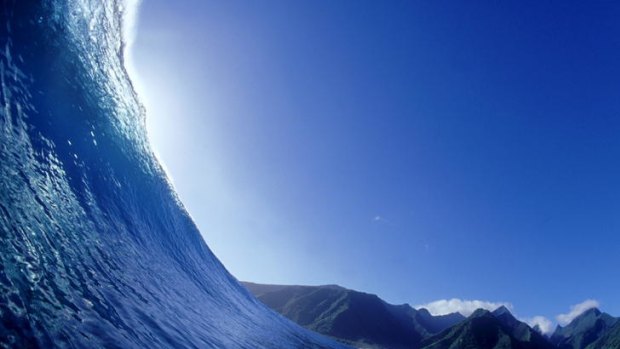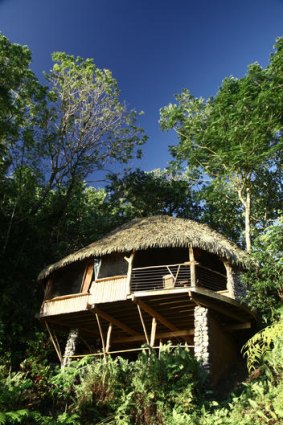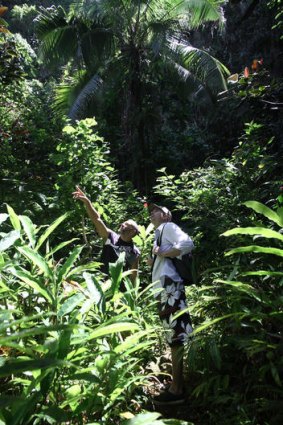This was published 12 years ago
Breaks with tradition
Best known for its monster swell, Teahupoo is also gateway to the Tahiti of popular imagination, writes Craig Tansley.

The famous Teahupoo surf break.Credit: Getty Images
THE road ends here at Teahupoo, just past 11-times world surfing champion Kelly Slater's new place by the lagoon. Around here the sweet stink of tiare - an aromatic gardenia that is Tahiti's national flower - taints the vaguely fishy sea breeze, diluting the smoky waft of backyard burn-offs. Polynesians have a penchant for tidiness.
Local fishermen hang freshly caught metre-long mahi mahi (dolphin fish) from frayed rope by the side of the road, yours for the right price; the only bargain you'll find in Tahiti.
You must've heard of Teahupoo. Each August-September the enormous waves that break onto shallow, razor-sharp reef here like "liquid napalm", as a local describes them, are ridden by the world's most accomplished surfers. These frightening images of men cheating death for glory in the Billabong Pro are sent live across the world to millions of homes. For two weeks, Teahupoo becomes the focus of the sporting world, mini stalls go up selling mango shakes, banana pancakes and Hinano beer, spectator boats crowd the lagoon and women flock seeking a famous boyfriend, if only for a night. Then, just like that, they disappear and Teahupoo is again just a tiny fishing village at the end of the road.

Vanira Lodge.
But I'm not here to surf Teahupoo, though it is every surfer's Everest. I'm here because the world never, ever goes beyond Teahupoo. And it's past Teahupoo where the Tahiti of your imagination - the clear lagoons, green-covered mountains and coconut trees of Mutiny on the Bounty - lies.
You'll have to go by foot, across some of the deepest valleys and highest mountains in all of French Polynesia. It's wild in there; this forgotten part of Tahiti Iti (Little Tahiti) is much more like the landscape of an outer island. Somehow progress missed this region entirely, leaving it more or less the same as the paradise glimpsed by Tahiti's very first visiting Frenchman, Louis de Bougainville, who declared he'd been "transported into the Garden of Eden" on arrival in 1768.
Or better still, why not ride as the locals do: by boat across a broad, blue lagoon. I take this option, speeding off from Vairao, five kilometres or so north-west of Teahupoo, jetting out along a deep passage of inky-blue ocean, passing tattooed, bare-chested locals in custom-built French Polynesian mahi mahi fishing boats. Framing the lagoon, gigantic triangular mountains - their tips covered in wispy cloud - drop a kilometre and more straight down, creating numerous shadowy, hidden valleys. The landscape is covered in a rich and thick billiard-table-green carpet of vegetation, all except the sheerest escarpments and peaks, far too rugged and rocky to sustain any life at all.

A hidden valley.
Our boat rises and falls as the powerful surge of ocean swells roll in beneath us, about to end their journey of thousands of kilometres on the shallow reef. Between us and the reef, a baby humpback whale surfaces shyly; mothers use the lagoons here as a sanctuary for calves away from the hungry mouths of predatory tiger sharks.
We enter the lagoon just west of Teahupoo; the water changes from royal blue to a shockingly bright shade of turquoise punctured by the fluorescent flash of coral and passing parrot fish. At the sleepy village of Teahupoo, a taxi boat driver - his two bare-chested, sun-tanned, bleached-blond-haired infant sons drape off the back of his vessel - tells our driver to look for pods of dolphins near the Teahupoo Pass.
Before he even finishes speaking, 15 or so dolphins surface beside us with a loud puff, then sink back into the water. The boat driver powers the boat and the dolphins play along, surfing the bow for the minutes it takes us to reach the famous Teahupoo reef break. Although it's small today, there's still enough power in the surges to imagine the nerve it must take to surf this place. It's a wave that's claimed lives - in 2000, a local surfer broke his neck and back in three places and his face was smashed so badly he was unrecognisable - it is, without a doubt, the fiercest rideable wave on Earth.
We travel back inside the dead-still waters of the lagoon, past a gathering of basic bungalows built metres from the water. It was here at Pension Bonjouir that I stayed four years earlier on the night before I had my own battle with Teahupoo. Each wave during that long, sleepless night broke with such ferocity on the reef that the sound echoed around the bare walls of my bungalow, keeping me awake until dawn. When I finally built the resolve to catch a wave that next morning, I was dumped like a matchstick onto the reef without getting to my feet, smashing my surfboard and hip in the process and bidding a hasty retreat to the shore.
Beyond Teahupoo there are just 40 or so houses among the wilderness; simple affairs with no water or electricity, home to retirees and subsistence farmers who come to town only to buy and sell fruit and vegetables at market. Their children are picked up by speedboat for the round trip to school each morning. Most houses aren't much more than shacks that slope at ungainly angles; in their backyards fishing nets hang out to dry on lines spread between pawpaw trees.
Far above these ramshackle dwellings, a waterfall cascades 250 metres straight down into a hidden valley and I wonder why it is that no one but the most intrepid travellers ever venture to these parts. Why do travellers stop for a night or two near traffic-choked Papeete before flying off to French Polynesia's outer islands? If only they knew that the paradise they seek all along is here, just an hour's drive away.
The houses stop and there's nothing now but jungle and mountains; the highest - Mount Ronui - is a soaring 1332 metres.
There are numerous walks on offer and if you're fit you can traverse the entire 22-kilometre roller-coaster track from east to west. When the lagoon ends near the barren-looking Te Pari Cliffs, waves pound a steep, rugged coastline. It's possible to hike the eight kilometres of this coastline with its remnants of ancient Polynesian life but you can only do it when the swell is small. Guides should be used - it takes two days to hike the whole Te Pari, camping overnight in beachside caves - but be warned that the stakes can be high if you try it unassisted and in bigger swells. Last year a student from Papeete and her boyfriend were dragged from the rocks by powerful waves and killed when they were pitched back onto the sharp reef.
The swells are much bigger here, and more uncomfortable, so we double back to where the Vaipori River flows down from the hinterland. The water here is fresh and much cooler than the ocean; it's so clear I spot gigantic eels on the river's bottom. Traipsing through mangroves, we shoulder our way past wild ginger, frangipani and hibiscus trees. There's shade here from the ever-present Polynesian sun and fresh water drops from a sheer volcanic cliff face high above.
There's a track that leads down inside the cliff. It's pitch black inside and after the harshness of the daylight it takes some time to make out what's below us. With a single torchlight between us, we walk down inside the mountain to a huge waterhole in an empty cave. Every sound we make reverberates off the damp walls. Legend has it that an ancient warrior eloped here with the Princess of Teahupoo when her father forbade the two to marry. Later, this cave became a place of initiation into manhood. Boys would prove their mettle by swimming to where the cave wall ends then finding their way back in the pitch blackness. The water here is cool, at least 10 degrees cooler than the lagoon, and I make my way to the end of the cave to a perfectly flat rock shelf ancient lovers used as their matrimonial bed. I turn off my torchlight and tread water like this for minutes in complete darkness with the slow drip of water the only sound.
We leave this sacred place and traverse the coastline to Tautira on Tahiti Iti's north coast, passing more cascading waterfalls, secret valleys and mountains that appear to grow straight up from the sea. On the return journey to Teahupoo the wind drops out entirely and the lagoon's surface is as smooth as a pond as a pod of dolphins joins us again on our bow wave.
We stop to savour the moment and I can only imagine how this scene must've looked 223 years ago to scurvy-ridden sailors fleeing 18th-century Europe.
I can't bring myself to leave this place, so I stay and sleep instead within the sweetly scented gardens of Teahupoo's Vanira Lodge. In the day's last light local children fish from the reef while others ride bicycles around the empty roads among wandering chickens and pigs. In the distance - across a mirrored lagoon - the sun sets against the impressive contours of Tahiti Nui and I imagine tourists sipping expensive cocktails in five-star resorts, awaiting the inevitable seafood buffet and island show. I'm happier instead with a slightly warm Hinano I bought from Teahupoo's only shop and the evening's first stars that are only just preparing themselves for the real island show tonight.
The writer travelled courtesy of Tahiti Tourism and Air Tahiti Nui.
Trip notes
Getting there
Air Tahiti Nui offers two weekly one-stop flights from Australia to Papeete, 1300 732 415, airtahitinui.com.au.
Staying there
Tahiti Travel Connection is offering seven-night deals from $2460 a person including return airfares from Sydney, transfers, four nights at Le Meridien on Tahiti Nui, three nights at Vanira Lodge on Tahiti Iti and three days' car hire, for travel until March 31. 1300 858 305, tahititravel.com.au; vaniralodge.com.
See + do
Take a boat tour with Tahiti Iti Tour and Surf from $85 for half a day, tahitiititourandsurf.pf. Natura Exploration offers all types of Tahiti Iti walks for $90 a day.
More information
tahitinow.com.au.
Sign up for the Traveller Deals newsletter
Get exclusive travel deals delivered straight to your inbox. Sign up now.